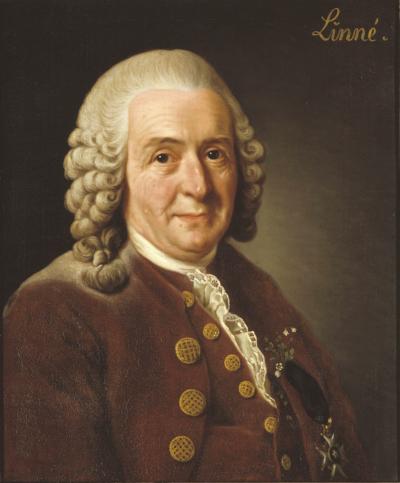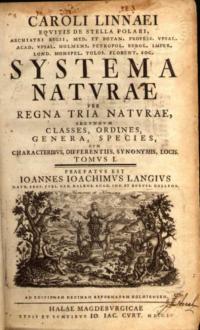 SKC Films Library |
| SKC Films Library >> Science >> Natural Science |
| Carolus Linnaeus [lih ne' us] creator of binomial nomenclature
Karl Linné was born in Räshult, Sweden, on May 23, 1707, the son of a pastor. His father wanted him to study for the ministry, but the youngster was so interested in plants that friends urged his parents to send him to medical school. While in medical school, he supervised a small botanical garden and began an insect collection. He wrote careful descriptions of all the kinds of plants he knew, and these notes formed the basis for his books. He became famous as Carolus Linnaeus because he wrote most of his books in Latin. Linnaeus studied medicine at the University of Uppsala, and was appointed lecturer in botany at that university in 1730. While still a student, Olaf Celsius engaged him to assist in the compilation of his Hierobotanicon. A review of S. Vaillant's sermo de Structura Florum (1718) and Wallin's Gamos Phyton (1729) led Linnaeus to examine the stamens and pistils of flowers, and, convinced of the importance of these organs, he formed the idea of basing a system of arrangement upon them. In 1732, Linnaeus explored Lapland for the Academy of Sciences; he published the scientific results of this exploration in Flora Lapponica (Amsterdam, 1737). In 1735, he showed a manuscript of his Systema Natura to Dutch naturalist Jan Frederik Gronovius, who was so impressed that he had it published at his own expense. After a visit to England in 1736, Linnaeus published his Genera Plantarum (1737), the work which is now considered the starting point of modern systematic botany. In 1738, he published Classes Plantarum. frontispiece of Systema Natura Returning to Sweden by way of France, Linnaeus settled down as a physician in Stockholm. He was subsequently appointed naval physician, with minor appointments. In 1741 he was appointed to the Chair of Medicine at Uppsala, but in 1742 exchanged it for the Chair of Botany. Just prior to this exchange, he travelled through Öland and Gothland, by command of the state, and published the results of his studies in Oländska och Gothländska Resa (1745). This volume's index shows the first use of specific names in nomenclature. Henceforward Linnaeus' time was taken up by teaching and the preparation of other works. Those works included: Flora Suecica (1745) and Fauna Suecica (1746); two volumes of observations made during journeys in Sweden, Wästgöta Resa (1747) and Skånska Resa (1751); Hortus Upsaliensis (1748); Philosophia Botanica (1751); and Species Plantarum (1753). The latter volume was the first in which the specific "genus-species" names of plants were fully set forth. In 1755 Linnaeus declined an invitation from the king of Spain to settle in that country, with a liberal salary. In 1761 he was granted a patent of nobility, antedated to 1757, from which time he was styled Karl von Linné. Karl von Linné [Carolus Linnaeus] died in the cathedral at Uppsala on January 10, 1778; he was buried in the same cathedral. Linnaeus' classification system, now called "binomial nomenclature," gives to each plant or animal two names. The first indicates the genus or related group to which it belongs, while the second gives the species or its specific name within the genus. Linnaeus himself recognized that the system was artificial and had its shortcomings, but it enabled students of botany and zoology to place plants and animals quickly and efficiently within a universally recognized category, at a time when scientific exploration of the world was at its height. His basic approach to plants was to divide them into the flowering and non-flowering, and to then subdivide the latter according to characteristics such as stamens and pistils. His whole system pays little attention to internal anatomy, which is particularly apparent when dealing with the animal kingdom. For example, he placed an extraordinarily diverse group of animals under the single group Amphibia. Linnaeus' system of classifying
plants, from Systema Natura
|
| SKC Films Library
>> Science >> Natural Science This page was last updated on 10/24/2017. |


